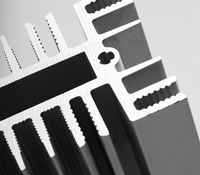Thermal expansion

When the temperature of aluminium is increased, the metal expands and this is called thermal expansion. One example of thermal extension is that if, for example, the temperature of a piece of aluminium alloy 6063 is -20 ̊C and its length is 2700 mm long, and it is heated to a temperature of 30 ̊C, it will subsequently be 2703 mm long due to thermal expansion. As a result of the adjustment of the temperature of the metal, thermal expansion of 3 mm is observed. The size adjustment of the metal is therefore important to consider, especially in environments with large temperature fluctuations.
If you would like to calculate the thermal expansion for your aluminium, use the following thermal expansion coefficient (λ): µm m-1 K-1.
Here you can see how we have calculated the earlier example of thermal expansion via the above coefficient:
- Thermal expansion coefficient λ = (µm)/(m∙K)
- Value for alloy 6063: 23.5 µm/(m * K)
- If the material is 2700 mm long at -20̊ C, the same material will be 23.5 µm/(m * K) * 2700 mm * 50 K (from-20̊ C to + 30̊ C) = 3172.5 µm = 3 mm at +30̊ C.




















